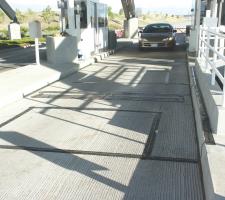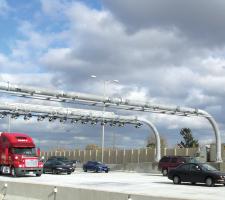
Bob Lees, Idris Technology
The move to all-electronic fee collection should be encouraging tolling authorities to look again at whether their vehicle classification criteria and technologies remain at all appropriate. Bob Lees of
The increasing use of All-Electronic Fee Collection (AEFC) is resulting in an ever-greater number of tolled facilities from which human participation in the transaction process has been removed.
Free-flowing AEFC is being pursued by many tolling authorities for several reasons all of which make perfect sense: economics, in the sense that the labour-intensive operation of toll plazas can be done away with; safety, where toll booth operatives are removed from the running lanes and the stop-start nature of traffic movements, with all its inherent dangers, becomes a thing of the past; and the environment, as the stationary and deceleration/acceleration phases of traffic are removed and emissions are reduced as a result.
This move to AEFC takes out of the equation a very useful, and certainly the most adaptable, detection and classification technology: the Mk.1 Human Eyeball. AEFC makes technology, in various forms, the primary means of classification and thereby hangs the problem; that which the aforesaid Mk.1 eyeball can detect can be difficult in some cases and outright impossible in others for consistent and reliable automated detection. The key change when moving to AEFC is the shift from technology confirming the operator's classification to technology being the only form of classification.
Broad spectrum
Worldwide, tolling authorities have developed over the years all manner of weird and wonderful classification categories and, between them, the human eye and its owner can readily determine even the most esoteric. For example, whether or not a vehicle has a sliding rather than an opening-and-closing rear door, the diameter of a vehicle's tyre bead or even whether an SUV has its rear seats up or down are all characteristics which can make a difference to the toll amount in some operations. Such characteristics can be extremely difficult, if not impossible, for technological solutions to differentiate, especially in a free-flow tolling environment. It must be remembered that these classification categories all made perfect sense at the time and may still do in the terms in which they were introduced. It is the desire to move to AEFC which should now raise the question as to their ongoing suitability. In addition a number of toll classification schemes are mandated by the charter which established the toll road in the first place. So any change to the classification scheme could involve one or more legislative change or require approval from bond holders and/or local stakeholders.Typically the move to AEFC takes the form of changing existing single lanes and adding free-flowing multi-lanes the full width and count of the main highway. In some cases the classification transition can be made: for example height over front axle can be equally well determined using appropriate technology. Another major change which has to be accommodated in most transitions is the move from an environmentally protected area (single lane with canopy) to one open to the full fury of the elements (multi-lane with just a spaceframe or gantries).
Aspiration versus reality
The aspiration, of course, is to make any change to AEFC at least revenue-neutral and the assumption tends to be that the detection and classification technology is there to solve any issue. The reality is that this isn't always the case.In the first instance, any technology choice must take into account the operational environment. In the desert, for example, where good visibility is the norm and rain is a rarity, pretty much any solution will do except, perhaps, a video system staring straight into the sun. In the northern states of the USA, by contrast, a detection and classification system has to be able to cope with diverse weather conditions from driving rain and snow to bright sunny days.
Unless a single class is used then some form of Automatic Vehicle Classification (AVC) will be required even if tag use is mandatory. And even then vehicle detection to ensure compliance with the tag requirements would be required.
On a greenfield site, it is possible to implement a classification system from scratch and therefore to take advantage of all available technology. In transitioning to AEFC from a traditional, barrier-based operation, there is a real need to address two main questions: 'Is my method of classification reasonable?' and 'Can it be measured by electronic means?' Some parameters, such as the number of axles or a vehicle's height, are readily ascertainable. Others, such as how its rear doors open and close, can be inferred electronically but not necessarily to an adequate degree of accuracy. Dual tyres, often a classification criterion, have long been difficult to discern and are more so in an open-road environment. It is, however, possible to combine some features, such as axle number and vehicle height. It is also possible, though difficult, to accomplish front and rear imaging, classification of some physical characteristics and tag reading from a single gantry. Using a single gantry, however, can limit the available technical choices. If the classification scheme is to be changed to accommodate AEFC then it would be wise to make the change to the existing system first to avoid major confusion to the customer.
Keep it simple
Revenue neutrality is achievable. The key is to make the classification system relatively simple. It must also take into account vehicular developments and buying habits: vehicle height over the front axle is a means of differentiating between cars and vans but the rise of the people carrier and SUVs has made the boundaries between private and commercial vehicles less clear.The more arcane classification systems leave the client confused. They affect the perception of a tolling scheme's 'fairness' and lead to higher levels of queries and complaints. The effect is to move the cost of toll booth operatives into the back office.
The consequences of fairness should not be readily dismissed either. It has come to be increasingly important in recent years. All too often, putting in place a tolled facility leads to the 'Law of Unintended Consequences' rearing its ugly head, for example resulting in an increase in diversions or rat-running. Tolling organisations, therefore, need to make huge efforts to positively differentiate themselves from the 'free' public roads which can often be found nearby.
Practical engineering solutions are needed. It is certainly true that tolling authorities and systems designers/ consultants have pushed the supply side to innovate. Without that push, it is unlikely equipment suppliers would have advanced the state of the art at anything like the pace we have seen. There also remain the practicalities of testing to consider. It is both complicated and dangerous to orchestrate a live body of vehicles to pass through an open-road multi-lane system. Live traffic testing can also be fraught with difficulties, although this is on balance a more realistic way of going about final acceptance testing.
Awareness
Policy setters need to be aware of what is consistent and practical. There are classification parameters external to the vehicle which are readily achievable. But as it stands some of the things being asked of technology are impractical with the current state of the art.HOT and HOV lanes are a case in point. There is clearly value in having HOT and HOV lanes. There are solutions and techniques which can see into the vehicle to determine how many people are in the vehicle but their efficiency is questionable. At present, human enforcement is the only truly reliable option.
That will change once cooperative infrastructure is in place and vehicles are able to speak to the roadside and, for HOT/HOV lane applications at least, let the local infrastructure know how many people they are carrying. Cognisant vehicles will address many of the current classification issues and make many of the more complex requirements much more practical. Both tolling and classification can then become parts of the vehicle's electronic and data 'payload'. But we are at least 20 years away from having anything like enough of the vehicle fleet appropriately equipped. Between now and then, notwithstanding the current economic climate, a lot of work still needs to be done to convince the automotive industry of the business case for incorporating standards-based vehicular aspects of cooperative infrastructure into their products.
Research and harmonisation?
This all pushes us towards the need for simpler classification regimes in the shorter term. It also drives the requirement for a body of work which takes a look at what can practically be measured from outside the vehicle. In addition, such a body of work should perhaps explore the cost benefits of externally derived information versus that which we will (eventually) be able to gain from inside the vehicle.Perhaps we will only start to make real progress when we move to a series of standardised systems of classification - although whether that goal will ever be achievable is very much open to debate. It is extremely unlikely that there will ever be a 'one size fits all' classification system.
Notwithstanding all the other considerations involved in moving to AEFC, however, some early thought about the eventual classification scheme deployed can avoid a lot of downstream aggravation and cost.













